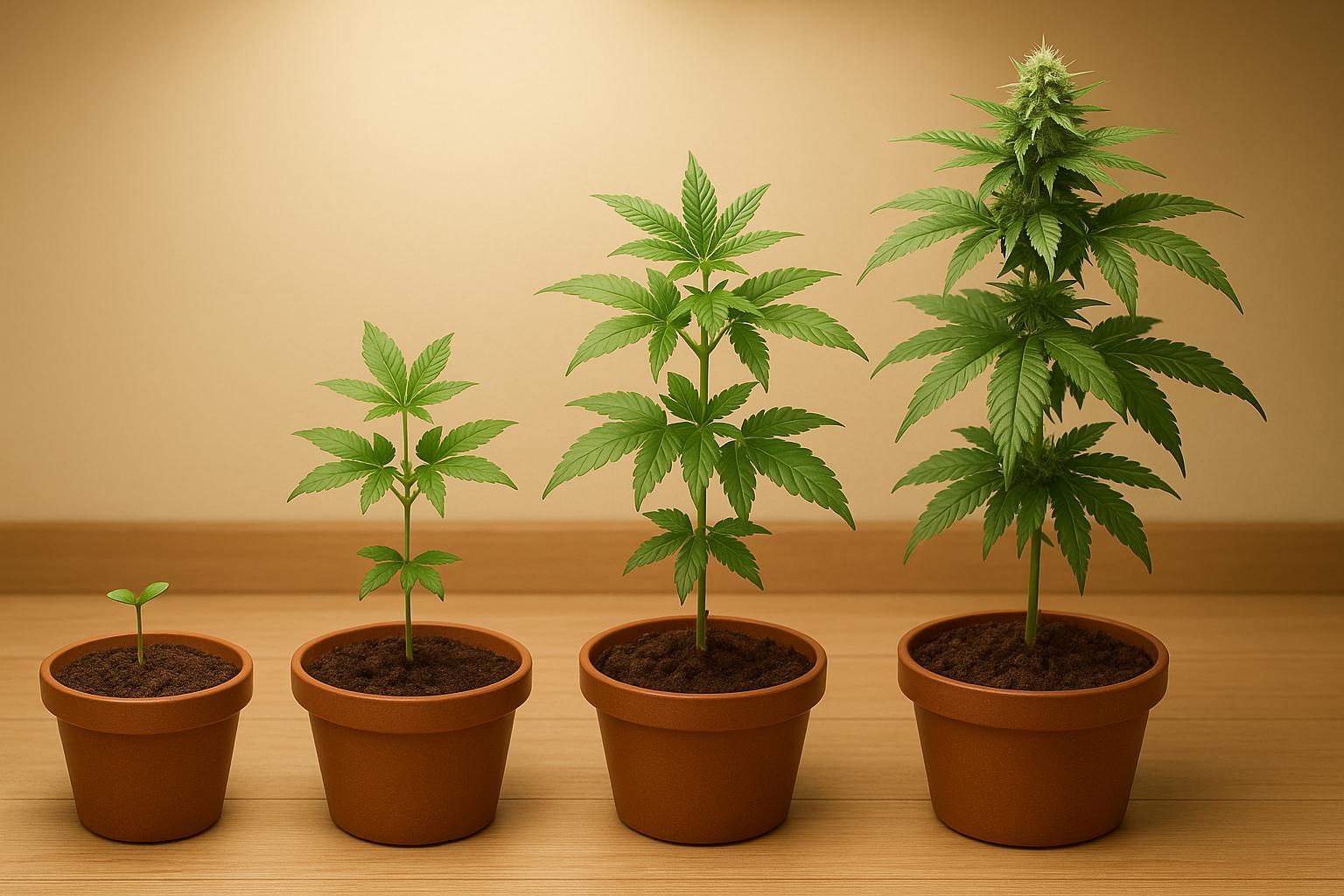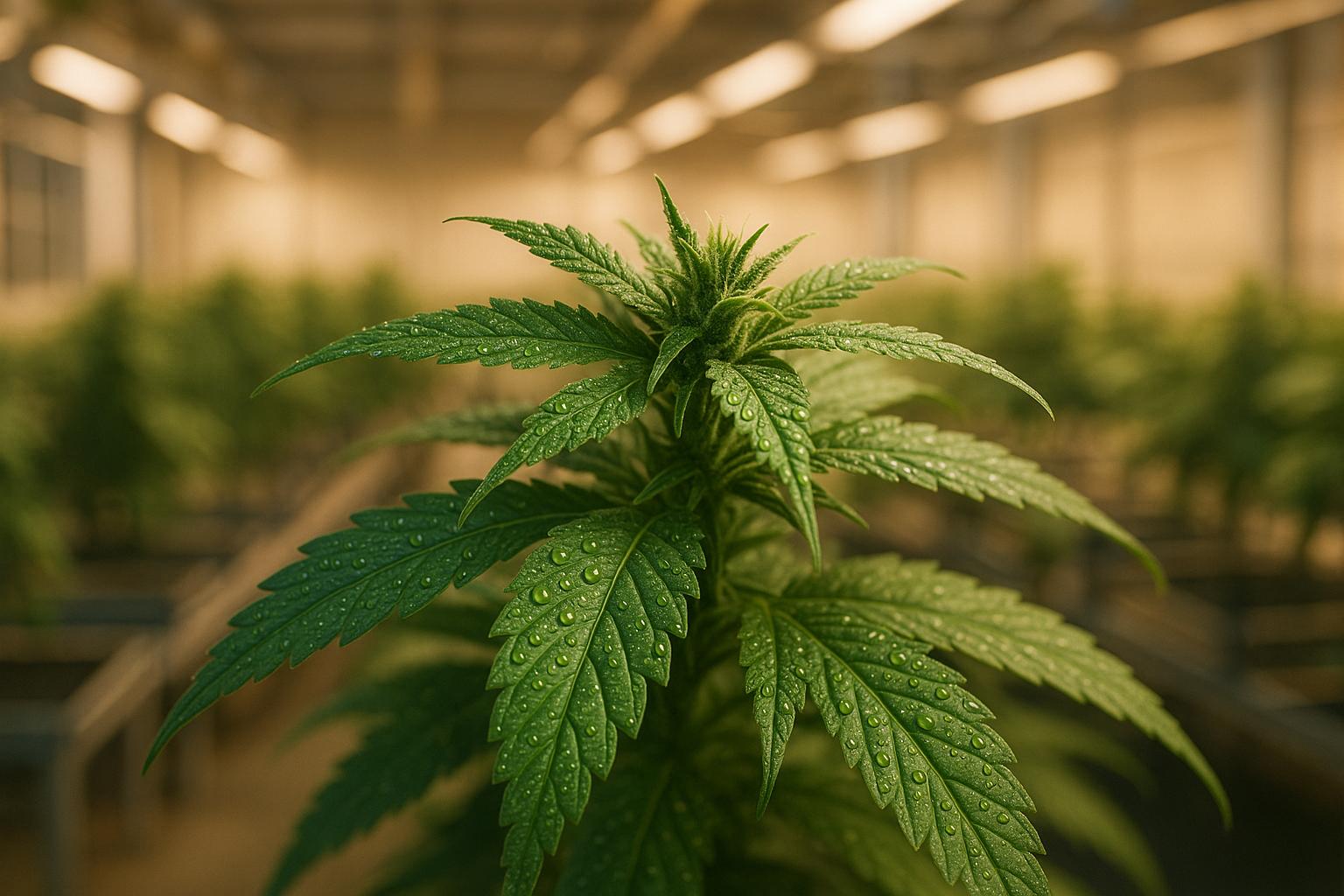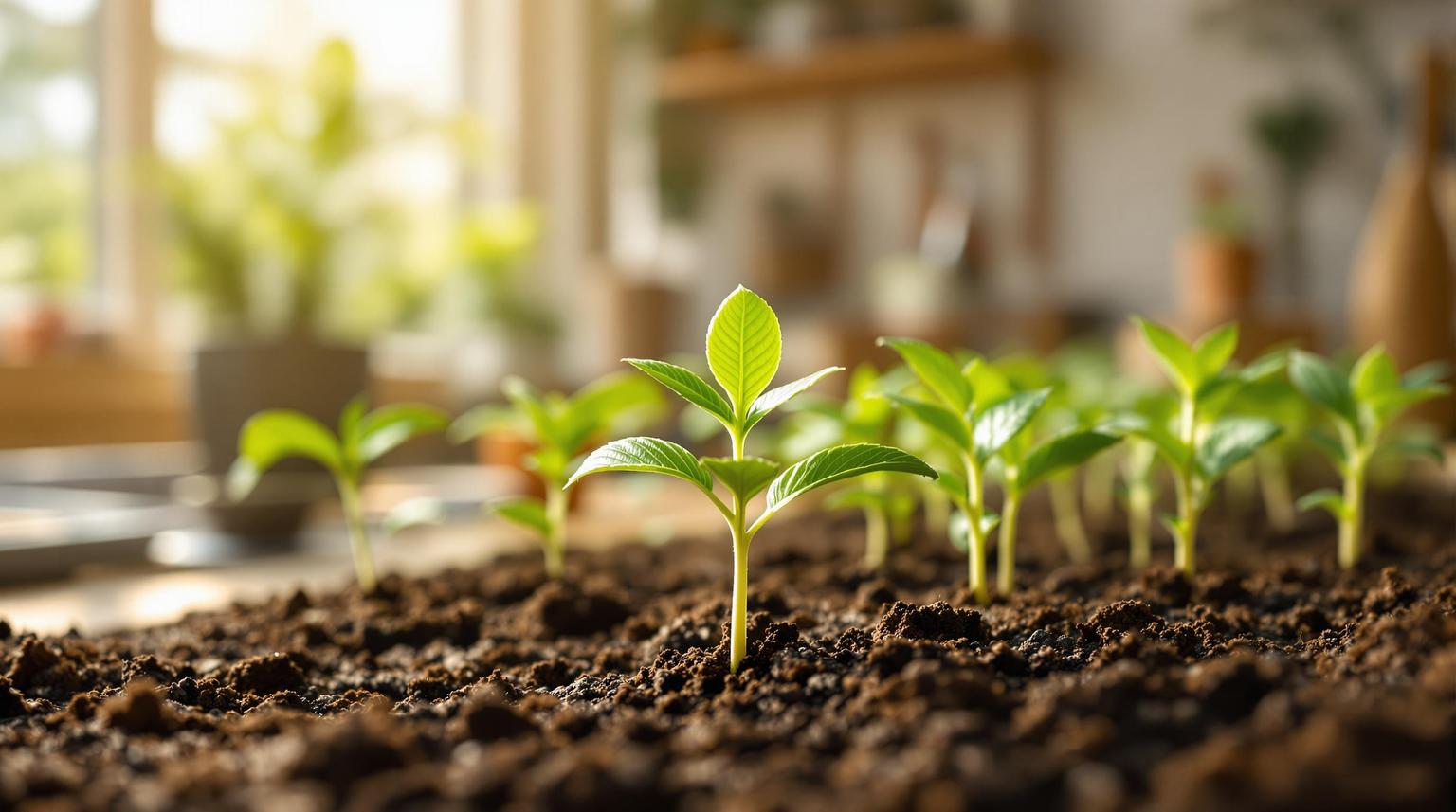Indoor and outdoor cannabis seeds are bred for different growing environments, and your choice depends on your climate, space, and experience. Here's a quick breakdown:
- Indoor Seeds: Thrive in controlled environments with artificial lighting. They grow compactly, offer consistent yields, and are ideal for limited spaces.
- Outdoor Seeds: Designed for natural conditions. They resist weather and pests, grow larger, and are suited for climates with ample sunlight.
Quick Comparison:
| Feature | Indoor Growing | Outdoor Growing |
|---|---|---|
| Space | Compact, ideal for small setups | Requires open, sunny areas |
| Yield | Consistent, smaller harvests | Larger harvest potential |
| Climate Dependency | Independent of weather | Relies on local climate |
| Care Needs | High maintenance, controlled setup | Lower maintenance, nature-driven |
| Costs | Higher due to equipment and energy | Lower initial investment |
Key Takeaway:
- Choose indoor seeds for full control over growth conditions and year-round cultivation.
- Opt for outdoor seeds if you have natural space and a suitable climate.
Your choice should align with your growing space, budget, and level of expertise.
Indoor or Outdoor Growing? Pros & Cons!
Indoor vs Outdoor Seeds: Basic Differences
Choosing between indoor and outdoor cannabis seeds is an important step in achieving the best results for your grow. Each type is specifically bred to perform well in its intended environment.
Indoor Seeds: Key Features
Indoor cannabis seeds are designed to thrive in controlled environments. These seeds are bred for compact growth, making them perfect for setups with limited space. When paired with artificial lighting and climate control, they deliver reliable yields.
Here are some key traits of indoor seeds:
| Feature | Benefit |
|---|---|
| Compact Growth | Makes efficient use of limited space |
| Consistent Yields | Produces predictable harvests under stable conditions |
Hybrid strains, which combine sativa and indica traits, are often used for indoor cultivation to achieve balanced growth and performance. On the other hand, outdoor seeds are optimized for natural conditions.
Outdoor Seeds: Key Features
Outdoor cannabis seeds are crafted to perform well in open environments. Their genetics make them tough, allowing them to withstand varying weather and develop natural defenses against pests and other challenges.
Key traits of outdoor seeds include:
| Characteristic | Advantage |
|---|---|
| Weather Resistance | Helps plants survive in changing climates |
| Natural Pest Resistance | Reduces vulnerability to common outdoor pests |
| Larger Growth Pattern | Increases potential harvest in open spaces |
| Climate-Specific Traits | Tailored to thrive in specific regional conditions |
In addition to these features, outdoor seeds offer other benefits that make them well-suited for natural environments.
"Choosing the right seeds for your climate can make all the difference between a bountiful harvest and a disappointing season." - Xavier Kief, Regenerative Cultivation Expert
Outdoor strains vary significantly based on their genetics. Indica strains are better suited for cooler regions with shorter growing seasons, while sativa varieties excel in warmer areas with longer growing periods. Many seed traits are intentionally developed to match specific climate zones.
Photoperiod strains, which rely on light cycles to control their growth phases, can deliver higher yields if their exposure to light and darkness is carefully managed.
Growing Conditions and Climate Needs
For successful cannabis cultivation, it's crucial to match the seed genetics to the right climate. Here's a breakdown of the requirements for controlled indoor setups and outdoor growing across various U.S. regions.
Indoor Growing Requirements
Indoor cultivation allows for precise control over key factors like temperature, humidity, light, and airflow, enabling consistent year-round harvests.
| Environmental Factor | Ideal Range | How to Control |
|---|---|---|
| Temperature | 70–80°F (day) / 65–75°F (night) | Climate control systems |
| Humidity | 40–60% (vegetative) / 30–50% (flowering) | Dehumidifiers or humidifiers |
| Light Exposure | 18/6 or 12/12 hours (depends on strain) | Timed grow lights |
| Airflow | Gentle, continuous movement | Oscillating fans |
Outdoor Growing Requirements
Outdoor cultivation comes with its own challenges, as growers must adapt to the natural climate. Here's how different U.S. regions impact growth:
| Climate Zone | Characteristics | Best Practices |
|---|---|---|
| Humid Subtropical (Southeast) | Long seasons, high humidity | Choose sativa-dominant strains with mold resistance |
| Mediterranean (California) | Warm, sunny weather | Most strains thrive in these conditions |
| Marine West Coast (Pacific Northwest) | Cool, cloudy climate | Use fast-flowering or autoflower strains |
| Highland/Alpine | Short seasons, temperature swings | Select high-altitude strains suited for these conditions |
Outdoor growers should note that reduced daylight (14–14.5 hours) signals feminized seeds to bloom. Fast feminized strains like Think Fast and GMO Fast bloom about a month earlier than traditional varieties, making them ideal for shorter growing seasons.
Outdoor Tips:
- Start seeds indoors before transplanting.
- Use poly tunnels or greenhouses for extra protection.
- In northern regions, autoflowering seeds are a great choice for quicker harvests.
Local features, such as mountains or proximity to oceans, create unique microclimates that can influence growing conditions. Understanding these factors helps in selecting the right seeds and refining cultivation strategies.
sbb-itb-1add288
Size, Yield, and Quality Results
After reviewing growth conditions, let's dive into the data comparing plant structure, yield, and chemical profiles for indoor and outdoor cultivation.
Growth and Yield Data
| Characteristic | Indoor Growing | Outdoor Growing |
|---|---|---|
| Plant Structure | Compact, with dense buds | Bulkier, fluffier buds |
| Height Control | Easier to manage in controlled spaces | Less control over plant height |
| Bud Density | Higher density | Less dense |
| Color Profile | Brighter, vibrant hues | Darker, earthier tones |
| Trichome Concentration | More concentrated | More dispersed |
| Root Development | Restricted in confined spaces | More fully developed systems |
These structural differences also influence chemical profiles. Indoor-grown plants often feature higher concentrations of THCA and CBCA, along with denser trichomes and consistent potency. On the other hand, outdoor cultivation enhances terpene profiles, offers a broader cannabinoid range, and supports natural microorganisms.
Some key takeaways include:
- Outdoor plants develop more extensive root systems.
- Terpenes tend to form naturally and more robustly outdoors.
- Indoor setups allow precise control over potency.
Both methods can produce outstanding results when handled with expertise. Understanding these differences will help you choose the right seeds and approach for your specific goals and growing conditions.
Care Requirements and Costs
Deciding between indoor and outdoor seeds involves understanding the care they require and the impact on your budget. Once you've reviewed growth and yield data, it's important to consider how daily maintenance and expenses differ for each setup.
Daily Care Needs
Indoor growing requires close attention to light, temperature, and humidity every day. Outdoor growing, on the other hand, depends more on nature, with occasional interventions.
Here’s how the daily care varies:
- Watering: Indoor systems follow scheduled watering routines, while outdoor plants rely on rainfall, supplemented by manual watering when needed.
- Temperature & Humidity: Indoor setups need constant adjustments to maintain the right conditions. Outdoor plants adapt to the local weather.
- Light Cycles: Indoor growers use artificial lighting on timers, whereas outdoor plants grow with the natural sunlight cycle.
- Pests and Pruning: Indoor systems allow for regular monitoring to prevent pests at a lower cost. Outdoor plants may require larger, less frequent treatments.
These care differences directly affect your overall costs.
Budget Planning
Indoor growing typically comes with higher upfront and ongoing expenses due to specialized equipment and energy use. Outdoor setups are less costly to start but can face unpredictable seasonal expenses.
Resource Usage
Indoor systems consume more resources, such as electricity for lighting and climate control. Water usage is also more tightly regulated in indoor setups. Outdoor growing takes advantage of natural sunlight and rainfall, reducing resource consumption. Greenhouses provide a balanced option, combining natural light with controlled environments to manage resources efficiently while maintaining some level of control.
How to Pick Your Seeds
Once you've considered care needs and costs, it's time to choose seeds that suit your growing conditions.
Key Factors to Consider
Choose seeds based on your climate, available space, and level of expertise. Here's how:
Climate Compatibility
Different strains thrive in different climates:
- Mediterranean zones (like coastal California): Try strains such as Jack Herrer or Girl Scout Cookies Extreme.
- Humid continental regions (Northeast or Midwest): Opt for hardy options like Super Lemon Haze Autoflower.
- Desert climates (Southwest): Look for heat-tolerant strains like Blue Dream or Tropicanna Cookies.
Space and Setup
| Growing Space | Recommended Seed Types | Best For |
|---|---|---|
| Small Indoor | Indica-dominant strains | Tight spaces, controlled environments |
| Large Indoor | Any strain with proper setup | Full control, year-round cultivation |
| Outdoor Garden | Sativa or hybrid strains | Seasonal growth with natural sunlight |
| Greenhouse | Versatile hybrids | A mix of natural and controlled conditions |
Experience Level
- Beginners: Start with forgiving strains like Northern Lights or White Widow that adapt easily to most climates.
- Outdoor enthusiasts: Let nature handle much of the work.
- Experienced growers: Consider strains that need precise environmental controls.
By focusing on these factors, you'll narrow down the best options for your setup.
Getting Expert Advice
Expert input can make all the difference. Resources like Cannabis Seeds Directory offer:
- Recommendations tailored to your climate
- Step-by-step growing guides
- Access to reliable genetics
- Ongoing cultivation support
When choosing seeds, look for:
- Germination guarantees
- Stability ratings for the strain
- Traits that fit your growing setup
- Built-in resistance to pests and local climate challenges
With expert help, you can ensure your seeds lead to a thriving and productive garden.
Conclusion
Deciding between indoor and outdoor cannabis seeds comes down to your goals and growing setup. Indoor seeds give you full control but require hands-on management, while outdoor seeds depend on natural conditions.
Here are three key factors to help you choose:
Climate Compatibility
Outdoor seeds thrive when matched to your local climate, while indoor seeds let you bypass weather challenges by creating the perfect conditions year-round.
Growing Environment
Think about your space and resources. Indoor setups need dedicated areas and equipment for climate control. Outdoor growing, on the other hand, requires a suitable natural space with access to sunlight and fresh air.
Experience Level
If you're new to cannabis cultivation, outdoor growing can be easier since nature handles much of the work. Indoor growing, while more demanding, allows for consistent results regardless of location.
"Growing cannabis seeds indoors requires the recreation of the ideal environment for cannabis of all kinds... Growing outdoors encourages nature to do all the hard work!"
Choose seeds that align with your environment, resources, and experience. Keep track of your growing process to refine and improve with each cycle.



